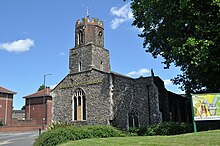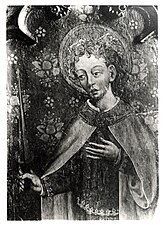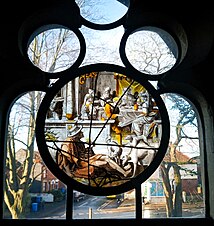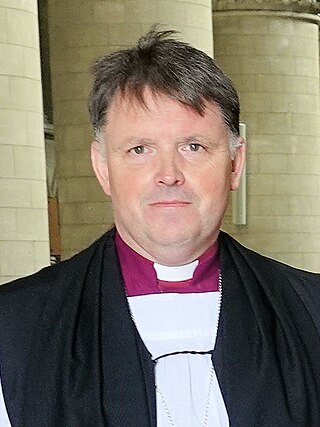
The Bishop of Norwich is the ordinary of the Church of England Diocese of Norwich in the Province of Canterbury. The diocese covers most of the county of Norfolk and part of Suffolk. The bishop of Norwich is Graham Usher.

Norwich Cathedral, formally the Cathedral Church of the Holy and Undivided Trinity, is a Church of England cathedral in the city of Norwich, Norfolk, England. The cathedral is the seat of the bishop of Norwich and the mother church of the diocese of Norwich. It is administered by its dean and chapter, and there are daily Church of England services. It is a Grade I listed building.
Ashby with Oby is a civil parish in the English county of Norfolk, which is located some 5 km or 3 miles north of Acle and 15 km or 9 miles north-west of Great Yarmouth. It named for the deserted mediaeval villages of Ashby and Oby, with their lost churches.

Snetterton is a village and civil parish in Norfolk, England. The village is about 9 miles (14 km) east-northeast of Thetford and 19 miles (31 km) southwest of Norwich. The civil parish has an area of 8.94 km2 (3.45 sq mi). The 2011 Census recorded a parish population of 201 people living in 74 households.

Mundford is a village and civil parish in the English county of Norfolk. It is situated at the intersection of two major routes, the A134 Colchester to King's Lynn road and the A1065 Mildenhall to Fakenham road, about 8 miles (13 km) north west of Thetford. The village is 35 miles (56 km) from the city of Norwich and 88 miles (142 km) from London.

Fordham is a small village and civil parish in the English county of Norfolk. The village is located 2.2 miles (3.5 km) north of Downham Market and 39 miles (63 km) west of Norwich, located along the A10 between London and King's Lynn and close to the confluence of the River Wissey and River Great Ouse.

The Church of St Helen, Ranworth, Norfolk is a church of medieval origins notable for its collection of church paintings. Known as "the Cathedral of The Broads", the church dates from the 14th century, although with origins in Saxon times. It contains a major collection of medieval artefacts, in particular the church's rood screen and the Ranworth Antiphoner, a liturgical manuscript.
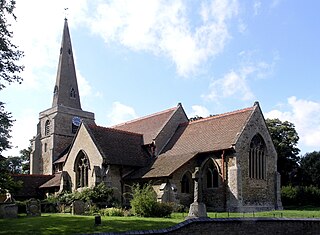
St James' Church, Stretham, is an active Anglican church in the village of Stretham, Cambridgeshire, England. Founded in the 12th century, it was heavily restored by the architect J. P. St Aubyn in 1876. English Heritage, a body responsible for preserving historical sites in the United Kingdom, assessed the church a Grade II* listed building. The turret clock on the east face of the tower was also made in 1876, by JB Joyce & Co of Whitchurch, Shropshire, and still keeps good time. The church has a ring of six bells hung for change ringing. Regular ringing resumed at the church in June 2011 after several years' silence. St James' is one of eight churches in the Ely Team Ministry.

St Mary's is an Anglican parish church in Elsing, a small village and civil parish in the Breckland district of Norfolk, England. The 14th-century church was built to a single plan in Decorated Gothic style by a local knight and has remained largely unaltered to the present day. The church contains a brass monument of national importance, a tall medieval font cover and rood screen paintings. The chancel retains some stained glass contemporary with the construction of the building.
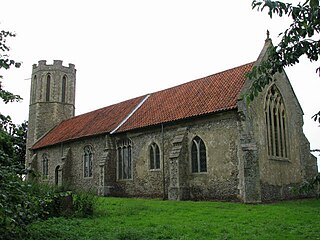
St Nicholas Church is a redundant Anglican church in the village of Buckenham, Norfolk, England. It is recorded in the National Heritage List for England as a designated Grade I listed building, and is under the care of the Churches Conservation Trust. The church stands among fields to the north of the River Yare.

St Mary's Church is a redundant medieval Anglican church in the village of Barton Bendish, Norfolk, England. This village had two more parish churches –St Andrew's Church, and All Saints' Church (demolished). St Mary's is recorded in the National Heritage List for England as a designated Grade I listed building, and is under the care of the Churches Conservation Trust. The architectural historian Nikolaus Pevsner was of the opinion that its west door is "one of the best Norman doorways in England". The church stands in an isolated position to the west of the village.

St Augustine's Church is a Anglican church building in the city of Norwich, Norfolk, England. It is recorded in the National Heritage List for England as a designated Grade I listed building. and is under the care of the Churches Conservation Trust. The church stands to the west of St Augustine's Street, the A1024 road, to the north of the Norwich inner ring road.

The Ranworth rood screen at Church of St Helen, Ranworth, Norfolk, is a wooden medieval rood screen that divides the chancel and nave, and was originally designed to act to separate the laity from the clergy. It is described by English Heritage as "one of England's finest painted screens".

St John the Baptist's Church, Timberhill, Norwich is a Grade I listed parish church in the Church of England in Ber Street, Norwich.

The Church of St Thomas the Apostle, Killinghall, is an Anglican parish church in Killinghall, North Yorkshire, England. It was designed in 1879 by William Swinden Barber when the parish of Ripley was split to create the additional parish of Killinghall, and a new building was required to accommodate a growing congregation. It was opened in 1880. Among the early vicars posted in this benefice were two canons, Sydney Robert Elliston and Lindsay Shorland-Ball, and the Venerable Robert Collier, an Irish missionary who served in India and Africa.

St Margaret's Church is the parish church of Hopton-on-Sea in the English county of Norfolk. It is dedicated to St Margaret of Antioch. St Margaret is also the dedication of the former church, which was destroyed by fire in 1865. The ruins of the former church remain standing, and are still consecrated. Both the old and new churches are Grade II* listed. Until 1974, Hopton-on-Sea was called Hopton ; the formal name for the benefice remains Hopton. The church is in the Diocese of Norwich, and is within the deanery of Lothingland and archdeaconry of Norfolk.

St Peter's is one of seven churches in the parish of Upper Tas Valley All Saints in south Norfolk, ten miles south of Norwich, UK. The full name is St Peter's and St Paul's, commonly known as St Peter's, and this was formerly the parish church for Forncett St Peter. It is an active place of worship and a nationally significant Grade I listed building. Its Anglo-Saxon round tower, built about 1000 AD, is considered one of the best in the country. There are other Anglo-Saxon features. Much of the main building is of later, mainly 14th and 15th century, date. Significant features are: the 1485 Drake tomb, a unique ancient staircase in the tower, carved pew ends, fine ledger slabs in the chancel and nave, good examples of Victorian coloured glass windows, and the ring of six bells. There is a comprehensive modern guide to the church. There is a connection with William Wordsworth: his sister, Dorothy, lived at the rectory from 1788 until 1794 with her uncle, the rector, William Cookson.

St Mary's Church is the parish church of Holme-next-the-Sea in the English county of Norfolk. It is dedicated to the Virgin Mary. The church is partly early 15th-century Perpendicular, and partly later reconstruction. It is Grade I listed.

Sir Peter Seaman (1662–1715), Knight Batchelor, of the City of Norwich in Norfolk, England, was a brewer who served as Mayor of Norwich 1707-8, Colonel of the City Corps and High Sheriff of Norfolk in 1710.

St Andrew's Church is the parish church of Raveningham in Norfolk, England, and in the Diocese of Norwich. It is a round-tower church, dating mostly from the medieval period. The building is Grade II* listed.
